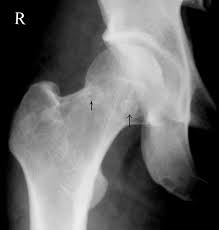[1]
Bergman J, Nordström A, Nordström P. Epidemiology of osteonecrosis among older adults in Sweden. Osteoporosis international : a journal established as result of cooperation between the European Foundation for Osteoporosis and the National Osteoporosis Foundation of the USA. 2019 May:30(5):965-973. doi: 10.1007/s00198-018-04826-2. Epub 2019 Jan 9
[PubMed PMID: 30627759]
[2]
Pascarella R, Fantasia R, Sangiovanni P, Maresca A, Massetti D, Politano R, Cerbasi S. Traumatic hip fracture-dislocation: A middle-term follow up study and a proposal of new classification system of hip joint associated injury. Injury. 2019 Aug:50 Suppl 4():S11-S20. doi: 10.1016/j.injury.2019.01.011. Epub 2019 Jan 17
[PubMed PMID: 30683569]
[3]
Belmahi N, Boujraf S, Larwanou MM, El Ouahabi H. Avascular necrosis of the femoral head: An exceptional complication of cushing's disease. Annals of African medicine. 2018 Oct-Dec:17(4):225-227. doi: 10.4103/aam.aam_75_17. Epub
[PubMed PMID: 30588938]
[4]
Duan Y, Xi Y, Cun X, Yang Y, Li B, Zhou J, Tang X, Li Z. [Treatment of avascular necrosis of femoral head in patients with human immunodeficiency virus infection by cementless total hip arthroplasty]. Zhongguo xiu fu chong jian wai ke za zhi = Zhongguo xiufu chongjian waike zazhi = Chinese journal of reparative and reconstructive surgery. 2018 Dec 15:32(12):1507-1511. doi: 10.7507/1002-1892.201806126. Epub
[PubMed PMID: 30569674]
[5]
Suksathien Y, Sueajui J. Mid-term results of short stem total hip arthroplasty in patients with osteonecrosis of the femoral head. Hip international : the journal of clinical and experimental research on hip pathology and therapy. 2019 Nov:29(6):603-608. doi: 10.1177/1120700018816011. Epub 2018 Dec 11
[PubMed PMID: 30526072]
[6]
Goyal T. Early results of surgery for femoroacetabular impingement in patients with osteonecrosis of femoral head. SICOT-J. 2018:4():47. doi: 10.1051/sicotj/2018038. Epub 2018 Nov 6
[PubMed PMID: 30398961]
[7]
Wang C, Meng H, Wang Y, Zhao B, Zhao C, Sun W, Zhu Y, Han B, Yuan X, Liu R, Wang X, Wang A, Guo Q, Peng J, Lu S. Analysis of early stage osteonecrosis of the human femoral head and the mechanism of femoral head collapse. International journal of biological sciences. 2018:14(2):156-164. doi: 10.7150/ijbs.18334. Epub 2018 Jan 14
[PubMed PMID: 29483834]
[8]
Kawano K, Motomura G, Ikemura S, Kubo Y, Fukushi J, Hamai S, Fujii M, Nakashima Y. Long-term hip survival and factors influencing patient-reported outcomes after transtrochanteric anterior rotational osteotomy for osteonecrosis of the femoral head: A minimum 10-year follow-up case series. Modern rheumatology. 2020 Jan:30(1):184-190. doi: 10.1080/14397595.2018.1558917. Epub 2019 Feb 18
[PubMed PMID: 30556788]
Level 2 (mid-level) evidence
[9]
Zhao P, Hao J. Analysis of the long-term efficacy of core decompression with synthetic calcium-sulfate bone grafting on non-traumatic osteonecrosis of the femoral head. Medecine sciences : M/S. 2018 Oct:34 Focus issue F1():43-46. doi: 10.1051/medsci/201834f108. Epub 2018 Nov 7
[PubMed PMID: 30403174]
[10]
Houdek MT, Wyles CC, Collins MS, Howe BM, Terzic A, Behfar A, Sierra RJ. Stem Cells Combined With Platelet-rich Plasma Effectively Treat Corticosteroid-induced Osteonecrosis of the Hip: A Prospective Study. Clinical orthopaedics and related research. 2018 Feb:476(2):388-397. doi: 10.1007/s11999.0000000000000033. Epub
[PubMed PMID: 29529674]
[11]
Ünal MB, Cansu E, Parmaksızoğlu F, Cift H, Gürcan S. Treatment of osteonecrosis of the femoral head with free vascularized fibular grafting: Results of 7.6-year follow-up. Acta orthopaedica et traumatologica turcica. 2016 Oct:50(5):501-506. doi: 10.1016/j.aott.2016.01.001. Epub 2016 Nov 16
[PubMed PMID: 27865611]
[12]
Sultan AA, Mohamed N, Samuel LT, Chughtai M, Sodhi N, Krebs VE, Stearns KL, Molloy RM, Mont MA. Classification systems of hip osteonecrosis: an updated review. International orthopaedics. 2019 May:43(5):1089-1095. doi: 10.1007/s00264-018-4018-4. Epub 2018 Jun 18
[PubMed PMID: 29916002]
[13]
Takashima K, Sakai T, Hamada H, Takao M, Sugano N. Which Classification System Is Most Useful for Classifying Osteonecrosis of the Femoral Head? Clinical orthopaedics and related research. 2018 Jun:476(6):1240-1249. doi: 10.1007/s11999.0000000000000245. Epub
[PubMed PMID: 29547501]
[14]
Steinberg ME, Oh SC, Khoury V, Udupa JK, Steinberg DR. Lesion size measurement in femoral head necrosis. International orthopaedics. 2018 Jul:42(7):1585-1591. doi: 10.1007/s00264-018-3912-0. Epub 2018 Apr 25
[PubMed PMID: 29691613]
[15]
Lerch TD, Vuilleumier S, Schmaranzer F, Ziebarth K, Steppacher SD, Tannast M, Siebenrock KA. Patients with severe slipped capital femoral epiphysis treated by the modified Dunn procedure have low rates of avascular necrosis, good outcomes, and little osteoarthritis at long-term follow-up. The bone & joint journal. 2019 Apr:101-B(4):403-414. doi: 10.1302/0301-620X.101B4.BJJ-2018-1303.R1. Epub
[PubMed PMID: 30929481]
[16]
Mallet C, Abitan A, Vidal C, Holvoet L, Mazda K, Simon AL, Ilharreborde B. Management of osteonecrosis of the femoral head in children with sickle cell disease: results of conservative and operative treatments at skeletal maturity. Journal of children's orthopaedics. 2018 Feb 1:12(1):47-54. doi: 10.1302/1863-2548.12.170141. Epub
[PubMed PMID: 29456754]

